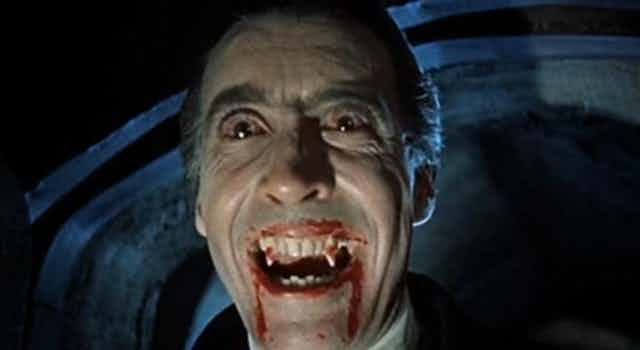They say your first Dracula marks you for life and that you will forever associate the Count with the actor who played him. My first experience of the most famous vampire of old time was Christopher Lee’s performance for Hammer Studios – and it has definitely stayed with me ever since.
I still remember watching his imposing on-screen figure, a mountain of a man, halfway between the quaintly aristocratic and the sexually feral, on a late-night, poorly Spanish-dubbed rerun of Hammer’s 1958 adaptation. Lee’s commanding presence, alongside his bloodshot eyes and fanged, gory mouth, gave me nightmares for days, but I was also seduced by his tragic, sensuous persona.

Years later, when I eventually watched the film in the original English, I was again bowled over by Lee’s performance, although this time for different reasons. Having acquainted myself with Bram Stoker’s novel of 1897 and its other famous film adaptations, I was more clearly on the lookout for what made Lee’s acting distinctive. There were subtleties I had not noticed before: his thunderous voice was deep and seductive; his accent was both elegant and assertive in a way that only a few actors like Dame Judy Dench or Sir Ian McKellen can manage, and also bespoke his aristocratic origin; his outfit (the cape of which I would have a chance to wear a few years later on my visit to the British Film Institute) was clearly the stuff of cinema myth.
Lee was greatly loved by many, both in and out of the cult horror circuits, especially after his many other classic appearances in the Lord of the Rings trilogy. But why was he such an icon for fans of dark cinema and vampire enthusiasts? What made him so distinctive and memorable that, to many, he is still the best Dracula ever to grace cinema screens?
Gothic tradition
I recently saw that the cover of Jonathan Rigby’s updated English Gothic (a landmark cinematic history of the genre) continues to portray a becaped, solemn Lee in all his glory. It is a summation, in one image, of Britain’s major Gothic export to the world: the Hammer Horror films of the late 1950s, 1960s and early 1970s, and their various recreations of monsters, which, alongside those of the Universal Studios, are the most popular ever conceived and have influenced countless other filmmakers and studios.
In his continued performances for them, and especially in the Dracula films, Lee managed to epitomise a number of interesting ideas about Britishness. I have mentioned his accent. It is interesting, for example, that the Count sounds recognisably English (as opposed to blatantly “other” in Bela Lugosi’s heavily accented performance) despite being from Transylvania, a fact which did not necessarily bother contemporary audiences.
His mixture of repressed, yet explosive, sensuality was a commendable preface to the swinging 60s and to a more liberal Britain. Lee managed to offer an intrinsically British Dracula that straddled the line between the national and the foreign, between the erotic and the respectable.
Beyond gravitas
For horror fans, Lee’s presence, especially over time, has become a marker of quality. His presence in the most Z-budget of eurohorror flicks, as well as performances in co-productions such as the Spanish-British Horror Express, which also featured that other legend of British Gothic cinema, Peter Cushing, has been enough to grant the films a solid and growing interest.

Lee has become shorthand for a respectable and national horror tradition that has made the genre palatable to those who, in the past, may have never gone near it. His Count brought a gravitas and a seductive quality to the vampire that has continued to develop throughout the 20th century and which has reached my generation in the form of Ford Coppola’s love stricken Bram Stoker’s Dracula of 1992, and even the sparkling and, for many, sacrilegious Edward Cullen from the Twilight series. For this, and for many other things, we need to thank Lee and Hammer.
I began by suggesting that our first Dracula is of great importance to our future perception of vampires. Perhaps it would be more accurate to say that adaptations of Dracula hinge quite dramatically on who is playing the Count because, more so than with any other monster, he stands in for all other vampires. Lee’s Dracula is nothing short of a national treasure that has further established the British credentials of this longstanding Gothic myth and, I have no doubt, will continue to be viewed as a landmark performance in cinema.

